Evaluation of the Robustness for Integrated Production Scheduling and Maintenance Planning Problem
Abstract
1. Introduction
2. Modeling and Assumptions
2.1. Machine Breakdown Modeling
- Machine breakdowns occur only during machine processing;
- Once the failure is fixed, the interrupted operation will continue to be processed from the point where it was interrupted;
- The downtime of the machine is constant.
2.2. Preventive Maintenance Formulation
2.3. Definition of Two Categories of Robustness
3. Completion Time of the Operation
- The preventive maintenance activities sequence;
- Location and time of corrective maintenance activities;
- The idle time between operations.
3.1. Impact of PM on Operational Completion Time
3.2. Influence of Machine Failure on Operational Completion Time
4. Robustness Measure for JSP with Preventive Maintenance
4.1. Monte Carlo Simulation
4.2. Analytical Approximation Calculation
| Algorithm 1 Pseudocode of Approximate estimate |
|
4.3. Surrogate Robustness Measures
5. Computational Results
5.1. Experiment Settings
5.2. Analysis of Different Robustness Measures
5.3. Performance Comparison with Other Surrogate Robustness Measures
5.4. Comparison between the Integrated PM Schedule and Non-PM Schedule
6. Conclusions
Author Contributions
Funding
Institutional Review Board Statement
Informed Consent Statement
Data Availability Statement
Conflicts of Interest
References
- Von Hoyningen-Huene, W.; Kiesmueller, G.P. Evaluation of the expected makespan of a set of non-resumable jobs on parallel machines with stochastic failures. Eur. J. Oper. Res. 2015, 240, 439–446. [Google Scholar] [CrossRef]
- Jin, Y.; Branke, H. Evolutionary optimization in uncertain environments—A survey. IEEE Trans. Evol. Comput. 2005, 9, 303–317. [Google Scholar] [CrossRef]
- Wu, Z.G.; Sun, S.D.; Xiao, S.C. Risk measure of job shop scheduling with random machine breakdowns. Comput. Oper. Res. 2018, 99, 1–12. [Google Scholar] [CrossRef]
- Ouelhadj, D.; Petrovic, S. A survey of dynamic scheduling in manufacturing systems. J. Sched. 2009, 12, 417–431. [Google Scholar] [CrossRef]
- Herroelen, W.; Leus, R. Project scheduling under uncertainty: Survey and research potentials. Eur. J. Oper. Res. 2005, 165, 289–306. [Google Scholar] [CrossRef]
- Leon, V.J.; Wu, S.D.; Storer, R.H. Robustness measures and robust scheduling for job shops. IIE Trans. 1994, 26, 32–43. [Google Scholar] [CrossRef]
- Mehta, S.V.; Uzsoy, R.M. Predictable scheduling of a job shop subject to breakdowns. IEEE Trans. Robot. Autom. 1998, 14, 365–378. [Google Scholar] [CrossRef]
- O’Donovan, R.; Uzsoy, R.; McKay, K.N. Predictable scheduling of a single machine with breakdowns and sensitive jobs. Int. J. Prod. Res. 1999, 37, 4217–4233. [Google Scholar] [CrossRef]
- Goren, S.; Sabuncuoglu, I. Robustness and stability measures for scheduling: Single-machine environment. IIE Trans. 2008, 40, 66–83. [Google Scholar] [CrossRef]
- Al-Hinai, N.; ElMekkawy, T.Y. Robust and stable flexible job shop scheduling with random machine breakdowns using a hybrid genetic algorithm. Int. J. Prod. Econ. 2011, 132, 279–291. [Google Scholar] [CrossRef]
- Zandieh, M.; Gholami, M. An immune algorithm for scheduling a hybrid flow shop with sequence-dependent setup times and machines with random breakdowns. Int. J. Prod. Res. 2009, 47, 6999–7027. [Google Scholar] [CrossRef]
- Paprocka, I.; Skolud, B. A hybrid multi-objective immune algorithm for predictive and reactive scheduling. J. Sched. 2017, 20, 165–182. [Google Scholar] [CrossRef]
- Ahmadi, E.; Zandieh, M.; Farrokh, M.; Emami, S.M. A multi objective optimization approach for flexible job shop scheduling problem under random machine breakdown by evolutionary algorithms. Comput. Oper. Res. 2016, 73, 56–66. [Google Scholar] [CrossRef]
- Liu, L.; Gu, H.Y.; Xi, Y.G. Robust and stable scheduling of a single machine with random machine breakdowns. Int. J. Adv. Manuf. Technol. 2007, 31, 645–654. [Google Scholar] [CrossRef]
- Xiong, J.; Xing, L.; Chen, Y. Robust scheduling for multi-objective flexible job-shop problems with random machine breakdowns. Int. J. Prod. Econ. 2013, 141, 112–126. [Google Scholar] [CrossRef]
- Hazir, O.; Haouari, M.; Erel, E. Robust scheduling and robustness measures for the discrete time/cost trade-off problem. Eur. J. Oper. Res. 2010, 207, 633–643. [Google Scholar] [CrossRef]
- Al-Fawzan, M.A.; Haouari, M. A bi-objective model for robust resource-constrained project scheduling. Int. J. Prod. Econ. 2005, 96, 175–187. [Google Scholar] [CrossRef]
- Kobylanski, P.; Kuchta, D. A note on the paper by M. A. Al-Fawzan and M. Haouari about a bi-objective problem for robust resource-constrained project scheduling. Int. J. Prod. Econ. 2007, 107, 496–501. [Google Scholar] [CrossRef]
- Zhang, G.; Lu, X.; Liu, X.; Zhang, L.; Wei, S.; Zhang, W. An effective two-stage algorithm based on convolutional neural network for the bi-objective flexible job shop scheduling problem with machine breakdown. Expert Syst. Appl. 2022, 203, 117460. [Google Scholar] [CrossRef]
- Xiao, S.; Sun, S.; Jin, J. Surrogate Measures for the Robust Scheduling of Stochastic Job Shop Scheduling Problems. Energies 2017, 10, 26. [Google Scholar] [CrossRef]
- Chansombat, S.; Pongcharoen, P.; Hicks, C. A mixed-integer linear programming model for integrated production and preventive maintenance scheduling in the capital goods industry. Int. J. Prod. Res. 2019, 57, 61–82. [Google Scholar] [CrossRef]
- Khatami, M.; Zegordi, S.H. Coordinative production and maintenance scheduling problem with flexible maintenance time intervals. J. Intell. Manuf. 2017, 28, 857–867. [Google Scholar] [CrossRef]
- Rahmati, S.H.A.; Ahmadi, A.; Karimi, B. Multi-objective evolutionary simulation based optimization mechanism for a novel stochastic reliability centered maintenance problem. Swarm Evol. Comput. 2018, 40, 255–271. [Google Scholar] [CrossRef]
- Avalos-Rosales, O.; Angel-Bello, F.; Álvarez, A.; Cardona-Valdés, Y. Including preventive maintenance activities in an unrelated parallel machine environment with dependent setup times. Comput. Ind. Eng. 2018, 123, 364–377. [Google Scholar] [CrossRef]
- Cui, W.; Lu, Z.; Li, C.; Han, X. A proactive approach to solve integrated production scheduling and maintenance planning problem in flow shops. Comput. Ind. Eng. 2018, 115, 342–353. [Google Scholar] [CrossRef]
- Feng, H.X.; Xi, L.F.; Xiao, L.; Xia, T.B.; Pan, E.S. Imperfect preventive maintenance optimization for flexible flowshop manufacturing cells considering sequence-dependent group scheduling. Reliab. Eng. Syst. Saf. 2018, 176, 218–229. [Google Scholar] [CrossRef]
- Torres, P.J.R.; Mercado, E.I.S.; Santiago, O.L.; Rifon, L.A. Modeling preventive maintenance of manufacturing processes with probabilistic Boolean networks with interventions. J. Intell. Manuf. 2018, 29, 1941–1952. [Google Scholar] [CrossRef]
- Cui, W.-W.; Lu, Z.; Pan, E. Integrated production scheduling and maintenance policy for robustness in a single machine. Comput. Oper. Res. 2014, 47, 81–91. [Google Scholar] [CrossRef]
- Sevaux, M.; Sörensen, K. A genetic algorithm for robust schedules in a one-machine environment with ready times and due dates. Q. J. Belg. Fr. Ital. Oper. Res. Soc. 2004, 2, 129–147. [Google Scholar] [CrossRef]
- Abumaizar, R.J.; Svestka, J.A. Rescheduling job shops under random disruptions. Int. J. Prod. Res. 1997, 35, 2065–2082. [Google Scholar] [CrossRef]
- Muth, J.F.; Thompson, G.L.; Winters, P.R. Industrial Scheduling; PWS Pub. Co.: Boston, MA, USA, 1997. [Google Scholar]
- Davis, L. Job Shop Scheduling with Genetic Algorithms; Psychology Press: London, UK, 1985; pp. 136–140. [Google Scholar]
- Storer, R.; Wu, S.; Vaccari, R. New Search Spaces for Sequencing Problems with Application to Job Shop Scheduling. Manag. Sci. 1992, 38, 1495–1509. [Google Scholar] [CrossRef]
- Taillard, E. Benchmarks for basic scheduling problems. Eur. J. Oper. Res. 1993, 64, 278–285. [Google Scholar] [CrossRef]
- Yamada, T.; Nakano, R. A Genetic Algorithm Applicable to Large-Scale Job-Shop Problems. PPSN 1992, 2, 283–292. [Google Scholar]
- Della Croce, F.; Tadei, R.; Volta, G. A genetic algorithm for the job shop problem. Comput. Oper. Res. 1995, 22, 15–24. [Google Scholar] [CrossRef]
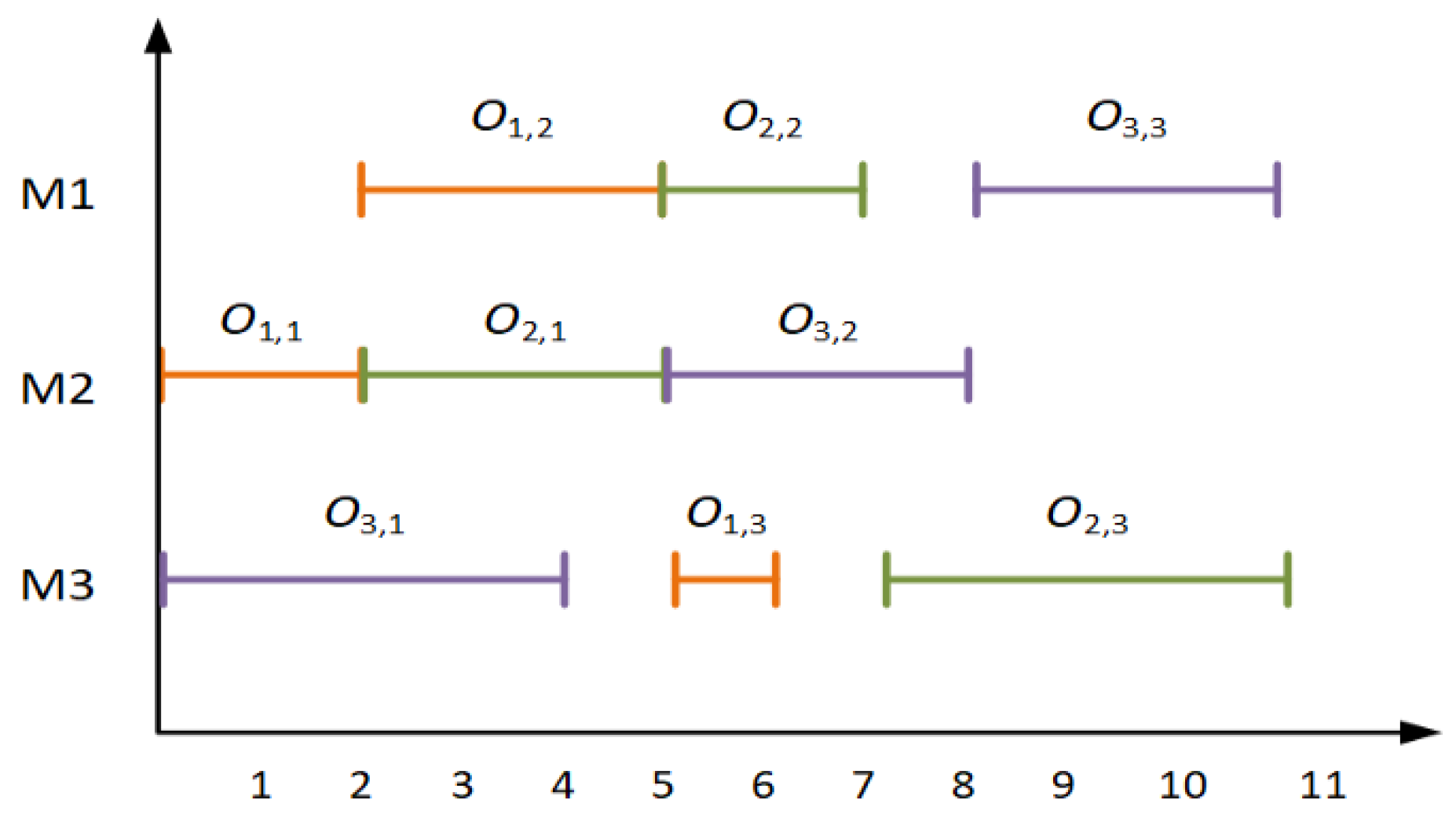
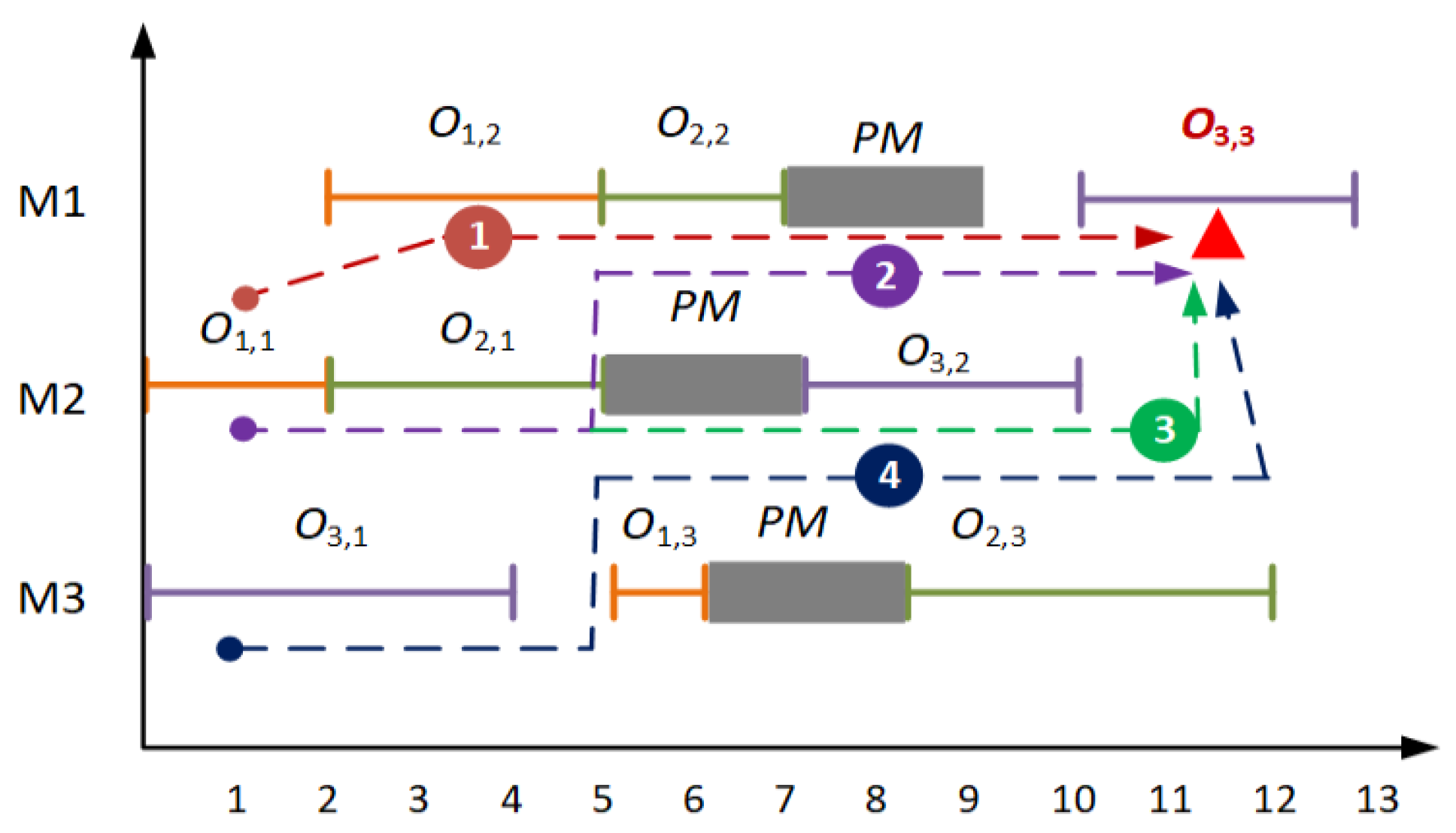
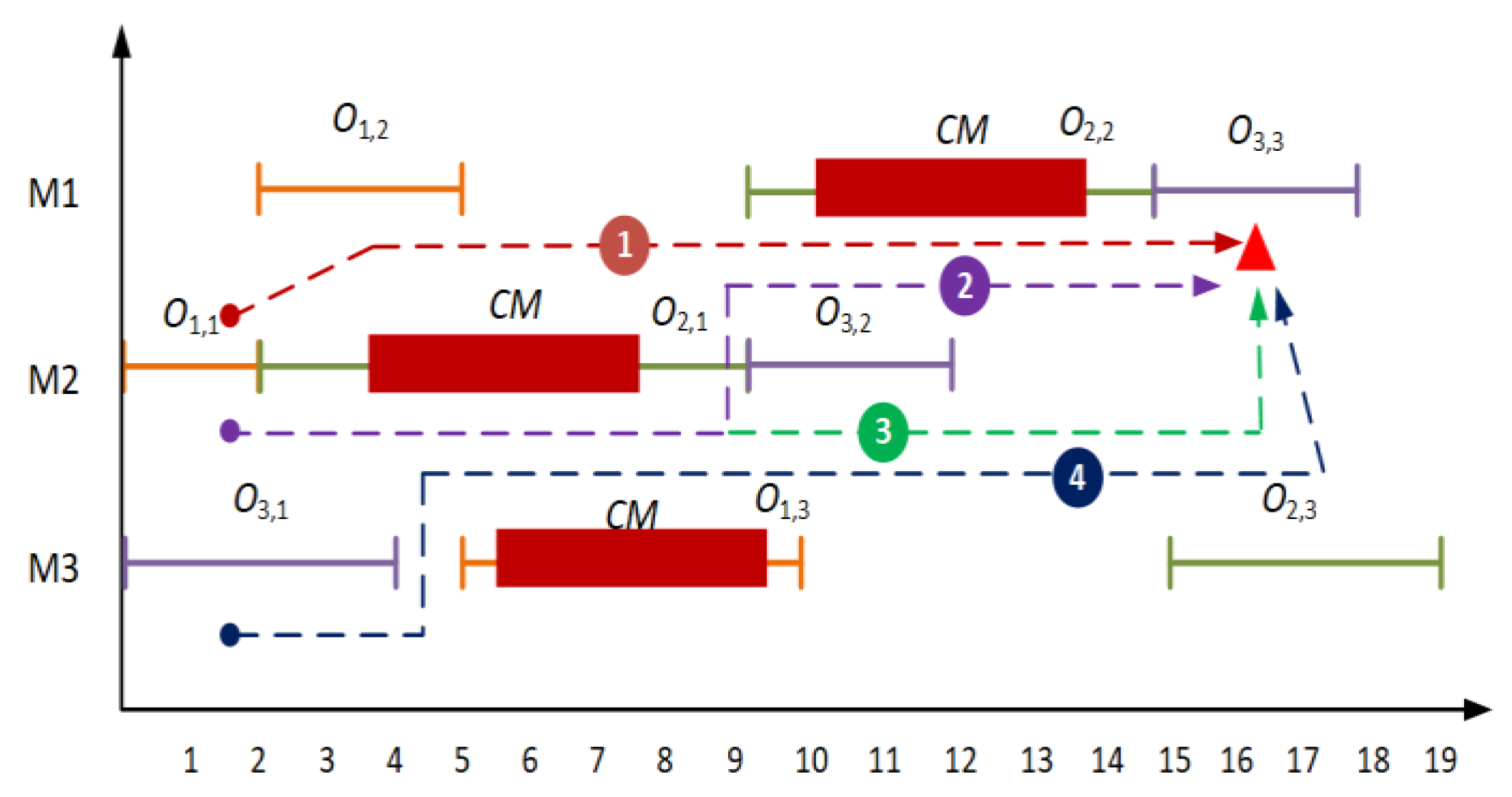


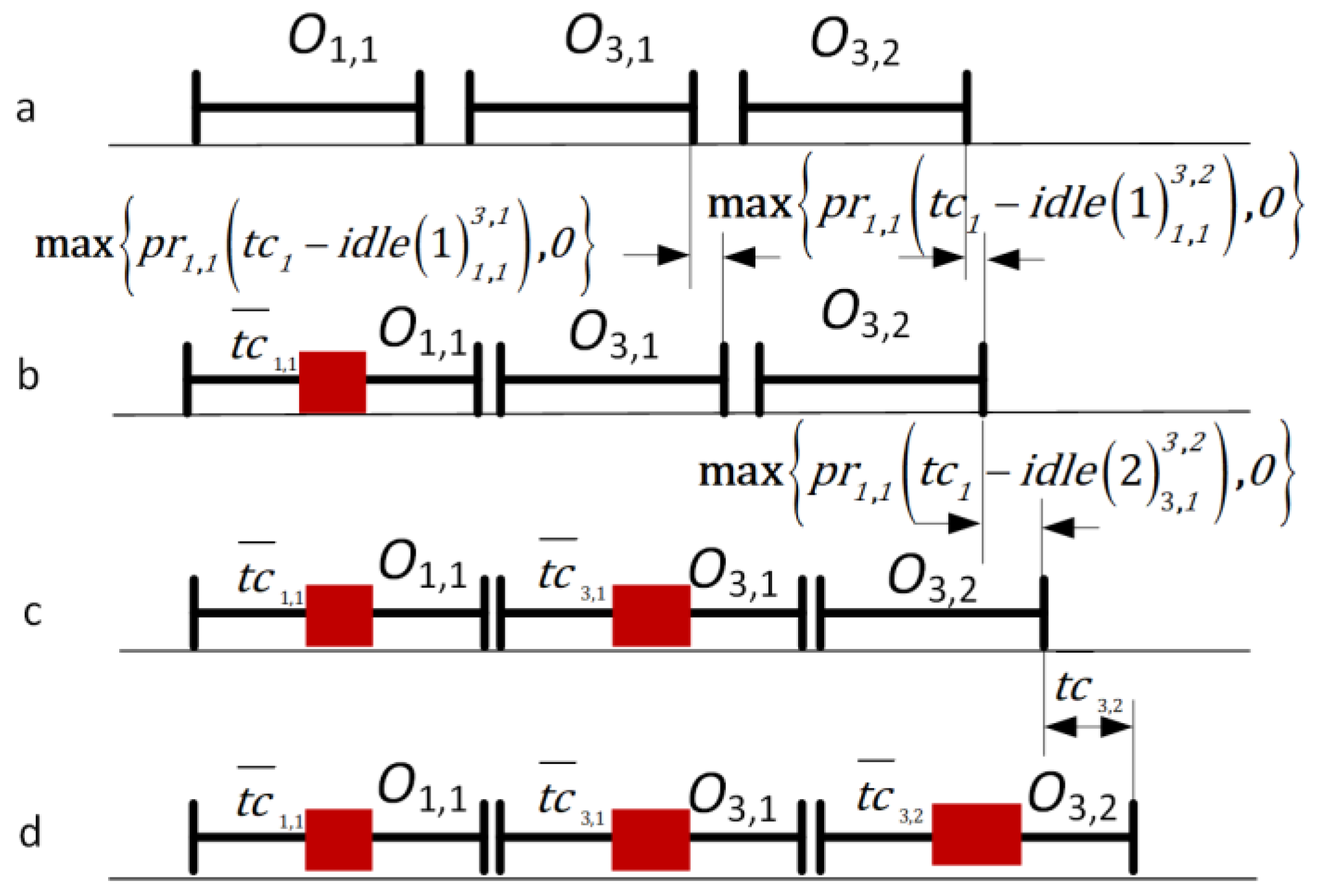
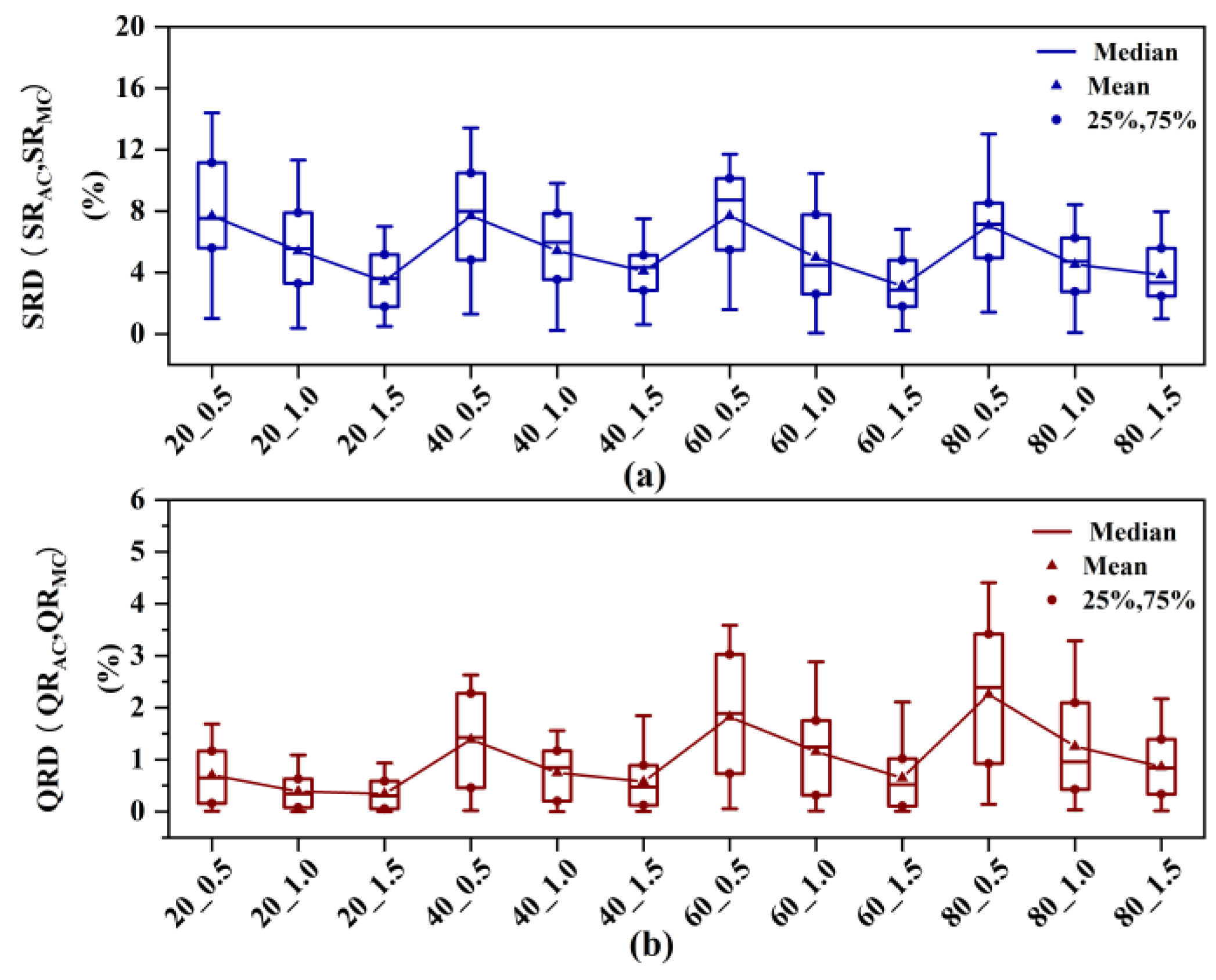
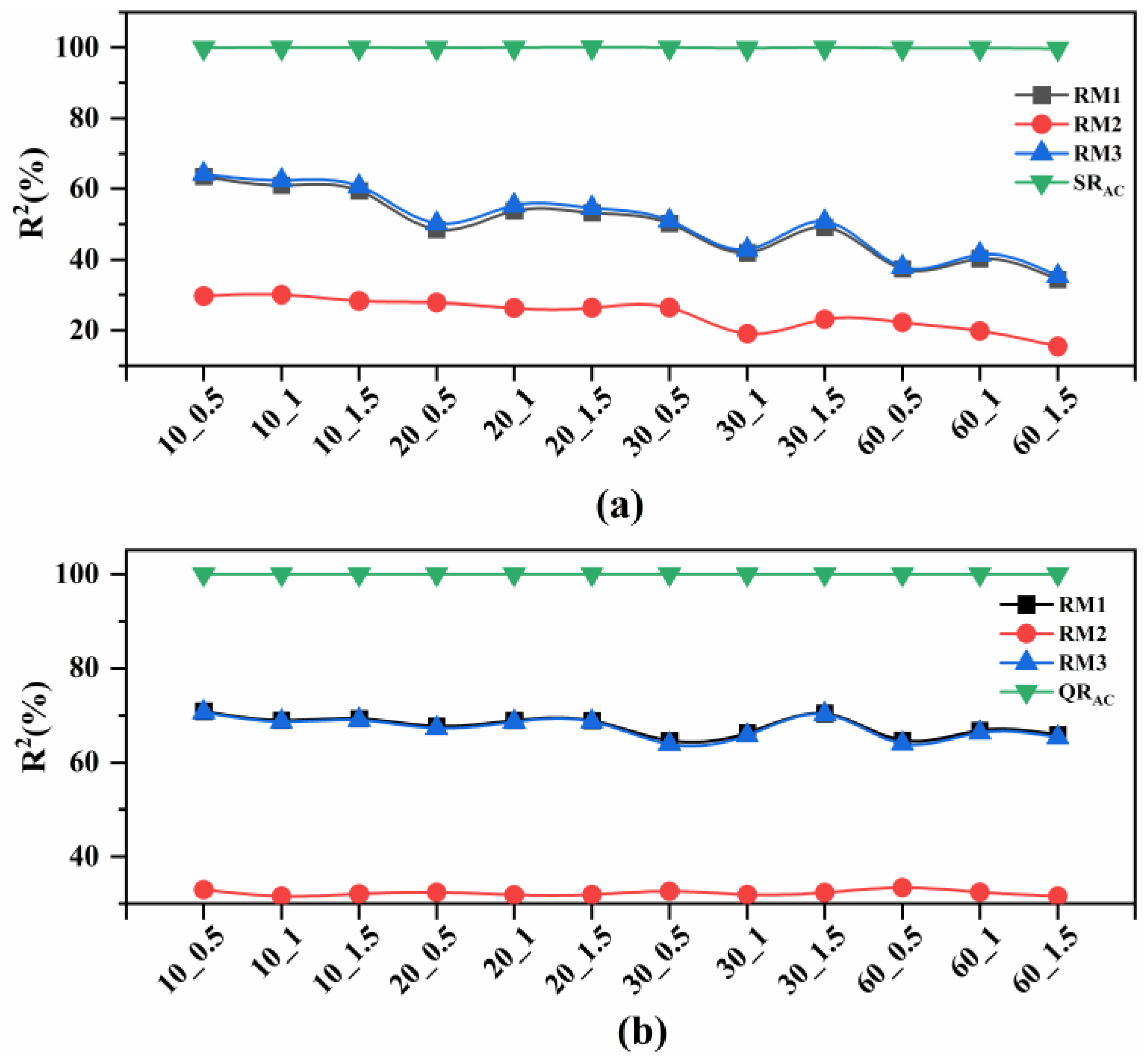

| Jobs | Processing Time of the Operations on Machine | ||
|---|---|---|---|
| J1 | |||
| J2 | |||
| J3 | |||
| CPU Times(s) | |||||||
|---|---|---|---|---|---|---|---|
| 20,0.5 | 7.75 | 4.14 | 0.71 | 0.59 | 2.28 | 699.09 | 0.35 |
| 20,1.0 | 5.42 | 3.28 | 0.39 | 0.35 | 2.17 | 398.73 | 0.43 |
| 20,1.5 | 3.37 | 1.98 | 0.34 | 0.29 | 2.18 | 354.85 | 0.55 |
| 40,0.5 | 7.69 | 3.78 | 1.39 | 0.94 | 2.37 | 526.72 | 0.40 |
| 40,1.0 | 5.45 | 3.12 | 0.75 | 0.53 | 2.23 | 434.06 | 0.47 |
| 40,1.5 | 4.08 | 1.97 | 0.58 | 0.53 | 2.19 | 288.29 | 0.62 |
| 60,0.5 | 7.63 | 3.19 | 1.82 | 1.24 | 2.37 | 524.15 | 0.39 |
| 60,1.0 | 5.15 | 3.17 | 1.16 | 0.83 | 2.31 | 321.47 | 0.59 |
| 60,1.5 | 3.06 | 2.03 | 0.66 | 0.58 | 2.60 | 374.06 | 0.66 |
| 80,0.5 | 7.08 | 2.93 | 2.27 | 1.42 | 2.76 | 496.42 | 0.44 |
| 80,1.0 | 4.54 | 2.44 | 1.27 | 0.98 | 2.65 | 443.40 | 0.60 |
| 80,1.5 | 3.67 | 1.95 | 0.87 | 0.62 | 2.65 | 295.36 | 0.74 |
| Mean | 5.41 | 1.02 | 0.52 | ||||
| RM1 | RM2 | RM3 | ||||||
|---|---|---|---|---|---|---|---|---|
| 20,0.5 | 0.495 | <0.001 | 0.414 | 0.002 | 0.512 | <0.001 | 0.992 | <0.001 |
| 20,1.0 | 0.388 | 0.003 | 0.376 | 0.003 | 0.403 | 0.002 | 0.996 | <0.001 |
| 20,1.5 | 0.285 | 0.013 | 0.312 | 0.008 | 0.296 | 0.011 | 0.996 | <0.001 |
| 40,0.5 | 0.369 | 0.003 | 0.303 | 0.010 | 0.397 | 0.002 | 0.994 | <0.001 |
| 40,1.0 | 0.229 | 0.028 | 0.223 | 0.030 | 0.243 | 0.023 | 0.997 | <0.001 |
| 40,1.5 | 0.232 | 0.027 | 0.222 | 0.031 | 0.246 | 0.022 | 0.999 | <0.001 |
| 60,0.5 | 0.334 | 0.006 | 0.262 | 0.018 | 0.352 | 0.005 | 0.997 | <0.001 |
| 60,1.0 | 0.147 | 0.086 | 0.150 | 0.082 | 0.156 | 0.076 | 0.997 | <0.001 |
| 60,1.5 | 0.125 | 0.116 | 0.143 | 0.091 | 0.135 | 0.102 | 0.998 | <0.001 |
| 80,0.5 | 0.420 | 0.001 | 0.349 | 0.005 | 0.432 | 0.001 | 0.996 | <0.001 |
| 80,1.0 | 0.360 | 0.004 | 0.291 | 0.012 | 0.378 | 0.003 | 0.997 | <0.001 |
| 80,1.5 | 0.192 | 0.047 | 0.185 | 0.051 | 0.202 | 0.041 | 0.997 | <0.001 |
| RM1 | RM2 | RM3 | ||||||
|---|---|---|---|---|---|---|---|---|
| 20,0.5 | 0.747 | <0.001 | 0.655 | <0.001 | 0.719 | <0.001 | 1.000 | <0.001 |
| 20,1.0 | 0.816 | <0.001 | 0.666 | <0.001 | 0.793 | <0.001 | 1.000 | <0.001 |
| 20,1.5 | 0.833 | <0.001 | 0.669 | <0.001 | 0.816 | <0.001 | 1.000 | <0.001 |
| 40,0.5 | 0.784 | <0.001 | 0.653 | <0.001 | 0.755 | <0.001 | 1.000 | <0.001 |
| 40,1.0 | 0.812 | <0.001 | 0.661 | <0.001 | 0.790 | <0.001 | 1.000 | <0.001 |
| 40,1.5 | 0.817 | <0.001 | 0.662 | <0.001 | 0.796 | <0.001 | 1.000 | <0.001 |
| 60,0.5 | 0.719 | <0.001 | 0.652 | <0.001 | 0.676 | <0.001 | 1.000 | <0.001 |
| 60,1.0 | 0.788 | <0.001 | 0.659 | <0.001 | 0.762 | <0.001 | 1.000 | <0.001 |
| 60,1.5 | 0.804 | <0.001 | 0.659 | <0.001 | 0.782 | <0.001 | 1.000 | <0.001 |
| 80,0.5 | 0.645 | <0.001 | 0.636 | <0.001 | 0.598 | <0.001 | 1.000 | <0.001 |
| 80,1.0 | 0.736 | <0.001 | 0.649 | <0.001 | 0.712 | <0.001 | 1.000 | <0.001 |
| 80,1.5 | 0.769 | <0.001 | 0.655 | <0.001 | 0.745 | <0.001 | 1.000 | <0.001 |
| 20,0.5 | 32.28 | 8.07 | 0.68 | 0.71 | 40.48 | 8.91 |
| 20,1.0 | −0.66 | 5.12 | −0.75 | 0.57 | 2.90 | 14.21 |
| 20,1.5 | −2.54 | 3.18 | −0.35 | 0.29 | −25.23 | 18.92 |
| 40,0.5 | 42.70 | 6.86 | 3.55 | 1.64 | 48.04 | 7.22 |
| 40,1.0 | 17.68 | 6.55 | −0.03 | 0.51 | 22.98 | 10.62 |
| 40,1.5 | −0.70 | 3.03 | −0.93 | 0.66 | −7.07 | 13.72 |
| 60,0.5 | 47.24 | 6.11 | 6.28 | 2.53 | 51.87 | 7.72 |
| 60,1.0 | 26.79 | 7.19 | 0.86 | 0.79 | 30.13 | 10.10 |
| 60,1.5 | 9.67 | 4.72 | −0.53 | 0.82 | 12.78 | 10.80 |
| 80,0.5 | 53.17 | 8.41 | 9.85 | 2.69 | 56.33 | 9.65 |
| 80,1.0 | 34.95 | 8.88 | 2.07 | 1.10 | 39.13 | 11.11 |
| 80,1.5 | 20.36 | 10.58 | 0.15 | 0.72 | 23.89 | 13.27 |
Disclaimer/Publisher’s Note: The statements, opinions and data contained in all publications are solely those of the individual author(s) and contributor(s) and not of MDPI and/or the editor(s). MDPI and/or the editor(s) disclaim responsibility for any injury to people or property resulting from any ideas, methods, instructions or products referred to in the content. |
© 2023 by the authors. Licensee MDPI, Basel, Switzerland. This article is an open access article distributed under the terms and conditions of the Creative Commons Attribution (CC BY) license (https://creativecommons.org/licenses/by/4.0/).
Share and Cite
Ba, Z.; Yuan, Y. Evaluation of the Robustness for Integrated Production Scheduling and Maintenance Planning Problem. Appl. Sci. 2023, 13, 2260. https://doi.org/10.3390/app13042260
Ba Z, Yuan Y. Evaluation of the Robustness for Integrated Production Scheduling and Maintenance Planning Problem. Applied Sciences. 2023; 13(4):2260. https://doi.org/10.3390/app13042260
Chicago/Turabian StyleBa, Zhiyong, and Yiping Yuan. 2023. "Evaluation of the Robustness for Integrated Production Scheduling and Maintenance Planning Problem" Applied Sciences 13, no. 4: 2260. https://doi.org/10.3390/app13042260
APA StyleBa, Z., & Yuan, Y. (2023). Evaluation of the Robustness for Integrated Production Scheduling and Maintenance Planning Problem. Applied Sciences, 13(4), 2260. https://doi.org/10.3390/app13042260





